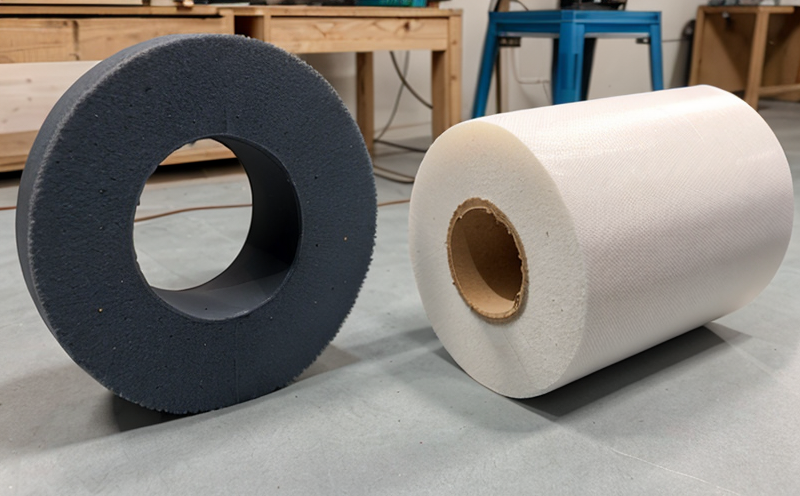ASTM D6007 Formaldehyde Emission Testing of Composite Wood Furniture Materials
The ASTM D6007 standard provides a comprehensive method for determining the formaldehyde emission from composite wood products, especially relevant to furniture manufacturing. This test is critical for ensuring compliance with strict environmental regulations and enhancing product quality by identifying potential health hazards associated with high formaldehyde emissions.
Composite wood materials are widely used in furniture construction due to their affordability, durability, and aesthetic appeal. However, these materials can release formaldehyde into the air, which poses a risk to human health if present at unsafe levels. Formaldehyde is classified as a known carcinogen by the International Agency for Research on Cancer (IARC). Therefore, accurate measurement of formaldehyde emissions is essential.
ASTM D6007 specifies the procedures for determining the amount of formaldehyde emitted from composite wood products over time. The test involves placing a specimen in a controlled environment where it is exposed to air flow and temperature conditions that mimic real-world usage scenarios. A gas chromatograph analyzer measures the concentration of formaldehyde released into this environment.
The testing process begins with precise preparation of the composite wood specimens according to ASTM D6007 guidelines. These specifications ensure uniformity across tests, thereby enhancing reliability. After preparation, the specimens are placed in a climate-controlled chamber designed to simulate typical indoor conditions. The emission rate is then measured over an extended period.
The accuracy and precision of ASTM D6007 testing depend heavily on the quality of materials used in specimen preparation and adherence to prescribed environmental parameters within the test chambers. Compliance with these standards ensures consistent results, which are crucial for regulatory compliance and consumer safety.
Understanding formaldehyde emission levels helps manufacturers make informed decisions about material selection and production processes. By adhering to ASTM D6007 guidelines, companies can produce safer furniture products that meet both legal requirements and market expectations regarding indoor air quality. This not only protects end-users but also supports sustainable business practices by reducing the environmental impact of manufacturing operations.
The importance of ASTM D6007 testing extends beyond mere compliance; it plays a pivotal role in promoting healthier living environments and fostering innovation within the furniture industry. As awareness grows about the risks posed by harmful volatile organic compounds (VOCs), including formaldehyde, there is increasing demand for low-emission products.
Manufacturers who adopt ASTM D6007 testing early on can gain a competitive advantage in meeting this growing market trend. They demonstrate their commitment to quality and safety while also contributing positively towards global efforts aimed at reducing indoor air pollution.
Why It Matters
The health risks associated with formaldehyde exposure cannot be overstated, making ASTM D6007 testing indispensable for composite wood furniture manufacturers. Exposure to high levels of formaldehyde has been linked to respiratory issues, cancer, and other serious illnesses.
By conducting ASTM D6007 tests regularly, companies can ensure their products meet stringent safety standards set forth by relevant authorities worldwide. This helps protect consumers from potential health hazards while enhancing brand reputation through transparent manufacturing practices.
In addition to safeguarding public health, rigorous testing also supports ongoing improvements in product design and development. Manufacturers can identify areas where emissions could be reduced further or alternative materials considered without compromising performance or aesthetics.
Furthermore, compliance with ASTM D6007 requirements enhances a company's ability to navigate complex regulatory landscapes confidently. As environmental regulations evolve globally, having robust testing procedures in place allows businesses to stay ahead of changing standards and maintain consistent quality across all markets.
Industry Applications
The application of ASTM D6007 formaldehyde emission testing is extensive within the furniture manufacturing sector. It applies not only to solid wood but also to various types of composite wood products such as particleboard, medium-density fiberboard (MDF), and engineered hardwoods.
Manufacturers involved in designing and producing chairs, tables, cabinets, and other furniture items made from these materials benefit significantly from this testing. By incorporating ASTM D6007 into their quality assurance processes, they can ensure that every piece of composite wood used meets the specified emission limits for formaldehyde.
This approach ensures consistency across all products regardless of location or target market. For instance, if a manufacturer operates facilities in different countries with varying environmental regulations regarding indoor air quality, ASTM D6007 provides a universal benchmark against which they can standardize their testing protocols.
The use of this standardized method also facilitates smoother supply chain management by providing clear indicators about the quality and safety of raw materials sourced from various suppliers. This transparency fosters trust between partners along with improved communication regarding expectations around emission levels.
Environmental and Sustainability Contributions
The adoption of ASTM D6007 formaldehyde emission testing contributes positively to environmental sustainability efforts in several ways. Firstly, it promotes the reduction of harmful emissions released into indoor spaces, thereby improving overall air quality for occupants. This aligns with broader goals related to enhancing public health outcomes and reducing pollution.
By minimizing formaldehyde release from furniture products, manufacturers contribute to creating healthier living environments both at home and in commercial settings like offices or schools. Such improvements are particularly beneficial for individuals who spend extended periods indoors, including children and elderly people who may be more vulnerable to the effects of poor indoor air quality.
The focus on reducing formaldehyde emissions also supports efforts aimed at promoting sustainable forestry practices by encouraging responsible sourcing of raw materials used in composite wood production. Sustainable forestry management helps maintain balanced ecosystems while ensuring that future generations have access to natural resources needed for manufacturing activities.
Incorporating ASTM D6007 testing into supply chain processes further strengthens commitments towards sustainability goals by fostering collaboration among stakeholders involved in product development and distribution. This collaborative approach encourages shared responsibility for environmental stewardship, leading to more effective implementation of best practices throughout the industry.





